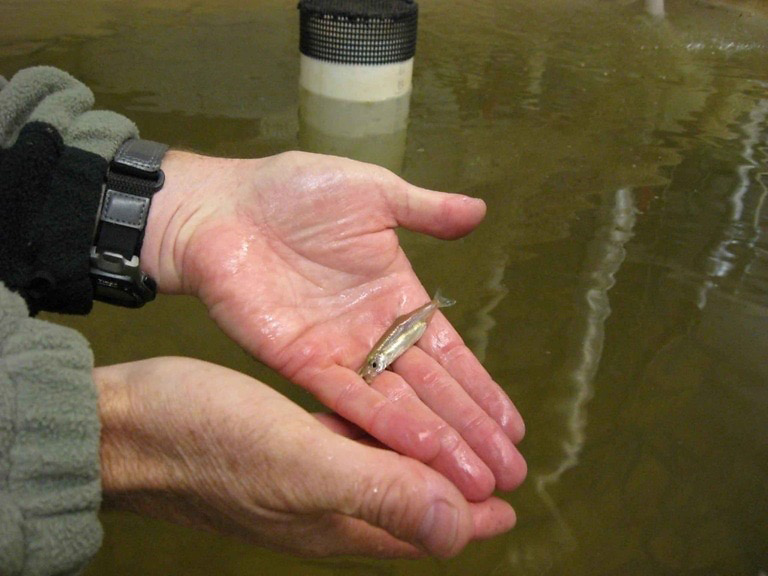It smells like cucumbers.
It tops out at 4 inches in length.
It is a luminous silvery blue color.
That is what a Delta smelt looks and smells like in a nutshell.
At one point, the fish that have a one-year life cycle were so plentiful that they were caught and sold commercially.
Today, the fish that are unique to the San Joaquin-Sacramento Delta are on the verge of extinction in the wild.
And they are being thoroughly cursed by farmers in the Southern San Joaquin Valley.
The reason is simple.
The fish plays a pivotal role in California’s perennial water wars.
Its shaky survival status has once again led to a drastic reduction of water being pumped from the Clifton Court Forebay near Tracy.
It is where pumps send water into the California Aqueduct and Delta-Mendota Canal.
This spring, despite record rains that snapped a prolonged drought, farmers contracted with the Central Valley Project are only receiving 40 percent of their allotment from the federal project.
It’s because when the pumps are running, the Delta smelt get sucked in and killed.
Now go back to recent droughts.
The Delta smelt benefited from massive releases of stored water to send more fresh water into the Delta in a bid to help them.
That also meant less water for growers in the southern part of the San Joaquin Valley.
Those releases have been criticized by impacted farmers who argue the water is simply going out to sea and not being diverted for human uses especially during drought periods.
They point to surveys of Delta smelt populations before and after such massive releases and note the decline in numbers haven’t slowed down.
The Delta smelt is listed as an endangered species.
It is also considered an indicator species. In other words, when the numbers drop it is a sign that the Delta’s ecological system may be failing other fish as well such as the Chinook salmon.
Two factors are believed to weigh heavily on the Delta smelt’s fate.
The biggest is the reduction in fresh water in the Delta since water started flowing southward via the California Aqueduct in the 1960s.
The movement of water from the north state to the south state is blamed for the overall decline of the Delta ecological system by allowing water salinity to increase.
Some believe putting in place the Delta tunnel being pursued by the Newsom Administration would accelerate brackish conditions in the Delta hurting the Delta smelt and other fish.
The other threat to Delta smelt are larger fish, particularly non-native striped bass and largemouth bass that were introduced to the Delta by man.
Those fish bring a fourth player to the water wars centered around the Delta, in addition to Delta area farmers and cities, Southern California cities and southern San Joaquin Valley farms, and environmentalists — sports fishermen.
Several scientists are predicting that the Delta smelt can’t survive in the wild given massive releases of fresh water haven’t helped their lot.
There are Delta smelt being bred in programs the University of California at Davis operates near Stockton and at a fish hatchery near Shasta Dam managed by the U.S. Fish & Wildlife Service.
And it is those hatchery bred Delta smelt that farmers contend are now being used to enforce federal and state regulations requiring the reduction in Delta water exports despite a flush year of precipitation year.
It’s an ironic twist because environmentalists in the Delta smelt’s corner have pushed the envelope that “wild” smelt need to be protected.
As such, hatchery and not wild fish are being protected..
Given the amount of non-native fish that dine on Delta smelt, there could easily be no wild Delta smelt left.
Researchers such as Peter Moyle — a professor of fish biology and associate director of the Center for Watershed Sciences at UC Davis – have pondered the question of how do we know when the Delta smelt is truly extinct in the wild as well as who makes the decision.
Moyer pointed out the last thicktail chub was caught in Delta’s Steamboat Slough in 1957, but was not recognized as extinct for 30 years. He noted, however, that there was no official government declaration that the thicktail chub was extinct.
There is a very good chance wild Delta smelt has already met the same fate.
In their place now, for all practical purposes, are hatchery bred Delta smelt.
However, if the Delta smelt are declared extinct in the wild, it won’t necessarily mean a change in water management policies.
There is a school of thought that other native fish, such as the Chinook salmon, longfin smelt, green sturgeon and Central Valley steelhead have benefited from water polices aimed at assisting the Delta smelt.
Keeping flows as high as possible to “protect” the Delta smelt makes sense to environmentalists.
That’s because they view the Delta smelt at the proverbial canary in the coal mine as being the most sensitive fish to changes in Delta waterways.
The health of the ecological system and the need for water that is being commandeered by regulations imposed by court decisions is why the 4-inch fish has become — depending upon how you look at things — the poster fish for all that is wrong with California water development, or the whipping fish for how state water policy has been skewed.
The devastating California drought is officially over but not for the handful of state and federal bureaucrats that owe their jobs to the Delta smelt.
Field research by the South San Joaquin Irrigation District and Oakdale Irrigation District point to non-native bass being a major culprit in declining Chinook salmon numbers and not water flows.
Then there’s the non-native invasive Asian clams introduced into the Delta in the 1980s that compete for the same food the Delta smelt does.
The Great Water Gods of D.C. and their Sacramento sidekicks don’t want to consider anything else being culpable for the Delta smelt’s dwindling numbers except for low water flows and the pumps.
It might be a bit different if they had hard data that supports their theory given that recent massive releases of water over the past 20 years haven’t done anything to change the downward projectory of the Delta smelt.
The U.S. Fish & Wildlife Agency several years ago stated “existing regulatory mechanisms (the releasing of large amounts of water) have not proven adequate” to slow down the Delta smelt’s decline since being listed in 1993 as an endangered species.
Those water releases are based on the 396-page “biological opinion” the agency released that pointed to the pumps as the main culprit in the decline of the Delta smelt.
The agency also noted “we are unable to determine with certainty which threats or combinations of threats are directly responsible.”
So what does the federal government do when nature has provided a water year with maybe enough rain and snow to avoid widespread disaster to faming and even river ecological systems next summer?
Dump more water into the ocean.




